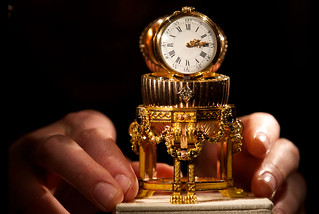
PREV ARTICLE
NEXT ARTICLE
FULL ISSUE
PREV FULL ISSUE
MORE ON THE VACHERON CONSTANTIN FABERGE EGG
Just in time for Easter, this Art Daily article has more information on the story of the recently discovered long-lost Faberge egg.
-Editor
This Fabergé egg, which is beautifully crafted and contains a Vacheron Constantin watch inside, is sitting on an elaborate, jewelled gold stand and measures 8.2 cm in height in total. It was given by Alexander III Emperor and Autocrat of all the Russians to his wife Empress Maria Feodorovna for Easter 1887. Easter is the most important of all Russian Orthodox festivals and it's a long established tradition to exchange Easter eggs. Carl Fabergé, goldsmith to the Tsars, created the lavish Imperial Easter eggs for both Alexander III and Nicholas II from 1885 to 1916. The Eggs are his most prized creations and have become bywords of luxury and craftsmanship. This egg was last seen in public over 112 years ago, when it was shown in the Von Dervis Mansion exhibition of the Russian Imperial Family's Fabergé collection in St. Petersburg in March 1902. In the turmoil of the Russian revolution the Bolsheviks confiscated the Egg from the Empress. It was last recorded in Moscow in 1922 when the Soviets decided to sell it as part of their policy of turning ‘Treasures into Tractors’. Its fate after this point was unknown and it is was feared it could have been melted for its gold and lost forever. It was only in 2011 that Fabergé researchers discovered that the Third Imperial Egg survived the revolution, when it was discovered in an old Parke-Bernet catalogue. Its provenance had been unknown and so it was sold at auction on Madison Avenue, New York on 7th March 1964 as a 'Gold watch in egg form case' for $2,450 (£875 at the time). This discovery started a worldwide race to discover the whereabouts of the egg, which was now worth tens of millions of dollars. In the meantime the egg was bought in the Mid-West of America at a bric-a-brac market. The buyer lived a modest live and tried to make extra money by buying gold and selling it for its scrap metal value. When he spotted the egg, he thought he could make an easy $500, although they had to pay $14,000 for its scrap metal value. But what had worked on many occasions, did not work this time. He had overestimated its worth and couldn’t sell it. No one spotted its potential and luckily no one offered more than the owner had paid for it, hence it was saved from the melting pot. The egg has several scratches on it where the metal was tested for its gold content. The egg became a financial burden to its unknowing owner. One evening in despair the owner tapped 'Egg' and 'Vacheron Constantin' into Google and a Telegraph article regarding the egg's survival appeared quoting Kieran McCarthy, director of Wartski, the London based, Royal Warrant holding experts on the work of Carl Fabergé. Recognising his egg in the article the owner was unable to sleep for days. He got on a plane to London to find Kieran and to show him images of the egg. Kieran was left speechless by the images and was almost certain the lost egg had been found, but to confirm its identity and ensure it was not a very clever fake, he travelled to the US. When he arrived in a small town in the Mid-West, he was shown into the kitchen of the owner’s home and presented with the egg, which was slightly smaller than the large cupcake positioned next to it. After an examination he confirmed that it was indeed the lost Imperial treasure. It had travelled from the hands of an Empress in the grandeur of Imperial St. Petersburg to a scrap metal dealer in modern day America. Wartski acquired the egg for a private collector, making the finder an art historical lottery winner, receiving multiple millions of dollars per centimetre of egg. The collector has generously allowed the egg to be displayed in London where it will be on view for only four days in a specially designed exhibition at Wartski. To read the complete article, see: Lost treasure found after almost 100 years: Wartski exhibits missing Fabergé egg (artdaily.com/news/69426/Lost-treasure-found-after-almost-100-years--Wartski-exhibits-missing-Faberg--egg#.U03cEPmcJRQ)
To read the earlier E-Sylum article, see:
IMPERIAL FABERGE EGG FOUND AT 'FLEA MARKET'
(www.coinbooks.org/esylum_v17n12a29.html)
The Numismatic Bibliomania Society is a non-profit organization promoting numismatic literature. See our web site at coinbooks.org. To submit items for publication in The E-Sylum, write to the Editor at this address: whomren@gmail.com To subscribe go to: https://my.binhost.com/lists/listinfo/esylum All Rights Reserved. NBS Home Page Contact the NBS webmaster 
|
